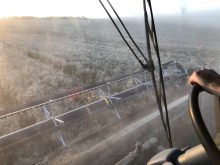Expected labour costs were the major difference in a new ruling on the index that determines how much revenue each of Canada’s big two railways get to keep in the coming crop year from hauling Prairie grain.
The Canadian Transportation Agency (CTA) on Thursday announced its decisions on the volume-related composite price index (VRCPI) for 2021-22. The index is the major variable in the formula that decides the railways’ maximum revenue entitlements (MREs) each crop year.
For the new crop year starting Aug. 1, Canadian National Railway’s VRCPI will be 1.4505, up 0.5 per cent from its figure for 2020-21, while Canadian Pacific Railway’s will be 1.4787, down 1.78 per cent.
Read Also

India slaps 30 per cent import duty on yellow peas
India has imposed a 30 per cent duty on yellow pea imports with a bill of lading date on or after Nov. 1, 2025.
Set each year by the CTA based on submissions from CN and CP, the VRCPI is an inflation factor based on a composite of forecast prices for railway labour, fuel, material and capital purchases.
Both railways expect to pay higher prices for fuel in 2021-22, but for CN, fuel prices were offset by relatively “moderate” increases in labour costs and material prices and a “projected decline” in its cost of capital, the agency said.
For CP, “expected declines in labour prices and cost of capital more than offset projected increases in fuel prices.”
With the new VRCPIs now in place, the MREs — the upper-limit dollar figures on the revenue CN and CP can earn for shipping regulated grain in a given crop year — must be set by the CTA for 2021-22 by Dec. 31, 2022 at the latest.
If Prairie grain revenue in a given crop year overshoots their MREs, the railways’ overages would then be payable to the Western Grain Research Foundation, the mandated beneficiary.
Revisions
The 2020-21 VRCPIs for both CN and CP have both shifted upward this year since they were first set in a CTA ruling in April 2020.
CN, in January this year, asked that its 2020-21 VRCPI be recalculated to account for costs it incurred obtaining hopper cars, “pursuant to 10 car supply agreements and three purchase agreements,” the CTA said.
The agency said March 24 it would bump up CN’s 2020-21 VRCPI from 1.4202 to 1.4433.
CP’s 2020-21 VRCPI, meanwhile, was reset Thursday in the wake of an April 9 decision by the Federal Court of Appeal, quashing a decision the CTA made in April last year over the rate at which it sets CP’s eligible cost of capital.
The appeals court ordered the CTA to set CP’s 2020-21 cost of capital rate using the same methodology it used for 2019-20 — a reset which bumps up CP’s 2020-21 VRCPI from 1.4205 to 1.5055.
The new 2020-21 VRCPIs will be used when the CTA calculates the railways’ 2020-21 MREs, a decision due by Dec. 31 this year.
The CTA said it had run consultations in late 2020 and early 2021 dealing with cost-of-capital issues, “with a view to addressing differences between the reporting of CN and CP through a single standard for both railway companies.”
Now, however, following the Court of Appeal’s decision, the CTA said it will run more consultations between now and late summer with CN, CP and “other interested stakeholders,” on the issue of whether to allocate the big two railways’ “general purpose” debt to their Canadian rail operations.
If the new round of consultations leads to a new reporting standard that would change how the agency determines CP’s cost of capital rate, the CTA said it will go back and review Thursday’s decision on the railways’ 2021-22 VRCPIs. — Glacier FarmMedia Network













